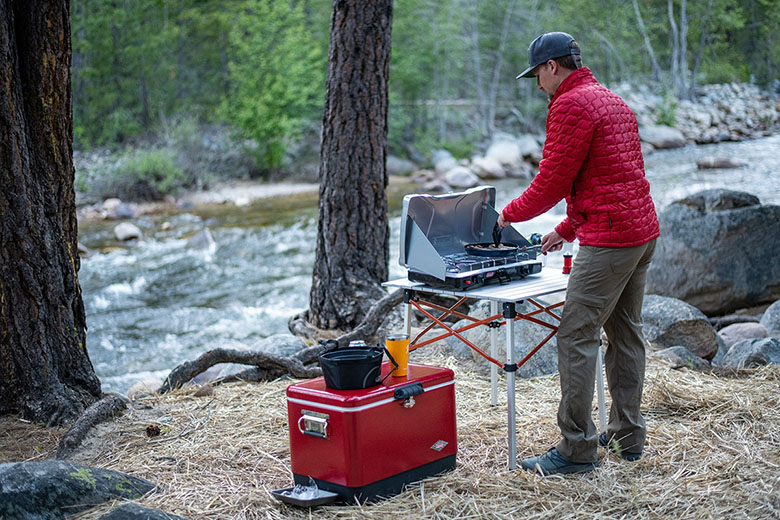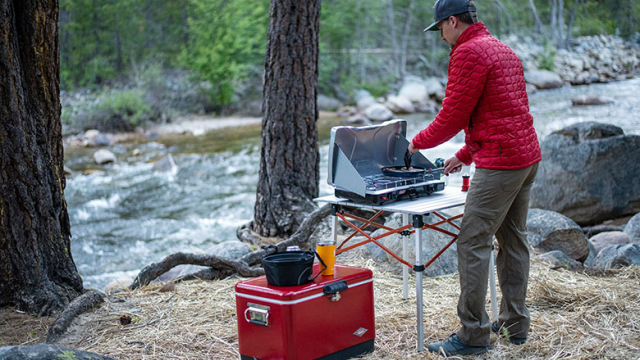When you’re car camping, weight and size don’t matter as much as they do when you’re backpacking. But fuel type does. You have three choices: propane, white gas, or isobutane-propane mix.
Propane is the heaviest and bulkiest of the three fuels—a Coleman two-burner stove with a full tank of fuel weighs about 10 pounds—but it’s also the easiest to use. Just screw on a canister, open the valve, and light it.
- Consider what type of camping you will be doing
- Backpacking stoves are typically small and lightweight, while car camping stoves are larger and heavier
- Decide if you need a stove that uses liquid fuel or one that burns solid fuel
- Liquid fuel stoves are more expensive but offer better performance in cold weather
- Choose a stove with the features that are important to you such as simmer control, wind protection, and self-cleaning capabilities
- Compare the weight and size of the stove to make sure it is portable enough for your needs
- Read online reviews of camp stoves before making your purchase to get an idea of which models have the best performance and value
How to Choose a Jet Boil for Backpacking & Car Camping: Stash vs Minimo vs Flash
Can You Use a Camping Stove in Your Car?
If you’re planning on doing some camping and want to be able to cook your meals, you might be wondering if you can use a camping stove in your car. The answer is yes, but there are a few things to keep in mind.
First, make sure that the stove is placed on a stable surface.
You don’t want it tipping over and causing an accident. Second, be aware of the ventilation in your car. If the stove is placed too close to a window or door, the fumes could build up and cause problems.
Third, keep an eye on the flame. If it gets too high, it could start a fire.
With these things in mind, using a camping stove in your car can be a great way to cook while you’re out camping.
Just be sure to use common sense and take precautions to ensure everyone’s safety.
What Type of Camping Stove is Best?
There are a variety of camping stoves to choose from, each with its own set of pros and cons. But which one is the best? To answer this question, you first need to decide what your priorities are.
Do you want a stove that’s lightweight and easy to transport? Or one that can cook large meals for a group? Perhaps you’re looking for something in between.
Once you know what you need, it’s time to start narrowing down your options. If weight is your top priority, an ultralight backpacking stove is probably your best bet. These models are designed to be as light and compact as possible, making them ideal for hikes and long-distance trips.
But they usually don’t have features like wind guards or simmer controls, so they might not be the best choice if cooking performance is more important to you.
If group cooking is on your agenda, then a camp chef stove is likely a better fit. These stoves are larger and heavier than backpacking models, but they offer more power and features, like multiple burners and ovens.
Some camp chef stoves even come with built-in griddles or pizza stones, so you can really get creative with your meals. Of course, all that extra stuff comes at a price: these stoves can be quite expensive.
And then there are all-purpose camping stoves that fall somewhere in the middle of the ultralight backpacking stoves and camp chef models.
These types of stoves typically have two burners and offer some basic features like wind guards and simmer control. They’re not as light or compact as backpacking models, but they’re also not as expensive as camp chef models. If you’re looking for a versatile stove that won’t break the bank, an all-purpose model might be the way to go.
What Kind of Stove Do I Need for Backpacking?
When it comes to backpacking stoves, there are three main types: canister, integrated canister, and liquid-fuel. Canister stoves are the lightest and easiest to use, while liquid-fuel stoves are the heaviest but most versatile. Here’s a breakdown of each type so you can decide which is right for you.
Canister Stove
A canister stove is small and lightweight, making it ideal for backpacking. It runs on propane or butane gas, which is stored in a small canister.
Canisters are easy to find and relatively inexpensive, making them a good option for occasional backpackers. One downside of canisters is that they don’t work well in cold weather since the gas doesn’t vaporize as easily at lower temperatures. Another downside is that you have to buy new canisters when yours run out, which can be expensive if you do a lot of backpacking.
Integrated Canister Stove
An integrated canister stove is similar to a canister stove but with one key difference: the fuel tank and stove are combined into one unit. This makes them slightly heavier than regular canisters stoves but still relatively lightweight overall.
Integrated canisters also tend to be more expensive than regular ones. The biggest advantage of an integrated system is that it’s less likely to leak since there’s only one connection point between the fuel tank and stove. This makes them a good choice for longer trips where you might not have easy access to replacement parts or fuel.
What are the Two Main Types of Backpacking Stoves?
There are two main types of backpacking stoves: canister stoves and liquid-fueled stoves. Canister stoves are small, lightweight, and easy to use. They’re powered by a small canister of compressed gas, which screws onto the stove.
Liquid-fueled stoves are slightly heavier and more complicated to use, but they’re more versatile because they can burn a variety of fuels, including white gas, kerosene, and unleaded gasoline.

Credit: www.switchbacktravel.com
Camping Stove
A camping stove is a portable stove that can be used for cooking while camping. There are many different types and designs of camping stoves, but they all have one thing in common: they allow you to cook food while you are away from home.
Camping stoves come in a variety of shapes and sizes.
Some are small and compact, perfect for backpacking or car camping. Others are larger and more powerful, ideal for cooking meals for a group of people. There are also camp stoves that run on different fuels, such as propane, wood, or even solar power.
No matter what type of camping stove you choose, it is important to read the instructions carefully before using it. This will help you understand how the stove works and how to use it safely.
Conclusion
There are a few things to consider when choosing a camp stove for backpacking or car camping. The first is the weight and size of the stove. You want something that is light enough to carry, but also large enough to cook for a group.
The second is the fuel type. Some stoves use liquid fuel, while others use canister gas. Liquid fuel is cheaper and easier to find, but it can be heavier and more difficult to use.
Canister gas is more expensive, but it is easy to use and doesn’t require as much maintenance. The third thing to consider is the features of the stove. Some have windscreens or built-in igniters, which can be very helpful in adverse conditions.
Others have multiple burners or simmer controls, which can be useful if you plan on doing a lot of cooking while camping. Finally, consider your budget when choosing a camp stove.
